If you don’t think looks are important, look at what’s happened to minivans . . . if you can find one to look at. Only a handful of them are still being made.
Chiefly – arguably – because of the way they look.
The way they function, on the other hand, has been taken over by crossovers like Honda’s Pilot – which is related to the company’s Odyssey minivan but doesn’t look anything like it.
And that’s probably why it (and others that look like it) sell so well, while minivans don’t.
What It Is
The Pilot is a mid-sized (bordering on full-sized) crossover with three rows of seats that’s related to the Odyssey minivan – but you’d never know by looking at them.
Like the Odyssey, the Pilot can seat up to eight people (including the driver) and both come standard with the same 3.5 liter V6 engine and ten speed automatic transmission. But the Pilot is available with all-wheel-drive while the Odyssey comes only with front wheel drive.
And the Pilot comes standard with something else the Odyssey doesn’t offer: The appearance of being something other than a minivan.
Prices start at $37,090 for the base trim LX with front-wheel-drive – which is less than the Odyssey stickers for ($38,240) to start.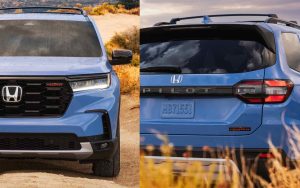
Adding AWD to the LX notches up the MSRP to $39,190.
A top-of-the-line Elite – which comes standard with AWD as well as a full digital instrument panel, a Heads-Up Display (HUD), heated and ventilated front seats, heated second row seats, a heated steering wheel and a 12 speaker Bose audio system – lists for $52,480.
There is also a TrailSport version that increases the Pilot’s off-road capability with a set of 18 inch all-terrain tires (plus a full-size spare in lieu of the space saver spare), increased ground clearance, skid plates and a suspension with more travel. AWD and a Class III hitch are also included.
The TrailSport stickers for $48,800.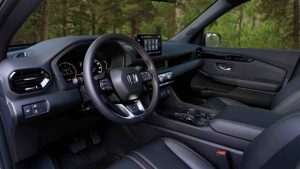
What’s New For 2024
The Pilot received a major makeover for the 2023 model year; the ’24 carries over the same as last year’s model.
What’s Good
Does most of the things a minivan does (and some things a minivan can’t) without looking like one.
Standard V6 (rather than a turbo four).
TrailSport version offers almost-SUV capability.
What’s Not So Good
Third row’s a tighter squeeze than a minivan’s third row – and it’s harder to get to them, because there aren’t sliding doors, like a minivan would have.
Minivans still offer more cargo room (and easier loading of cargo, being much lower to the ground).
A suite of backseat driver “advanced safety technologies” is standard in all trims.
Every Pilot comes standard with a 3.5 liter V6 that makes 285 horsepower, paired with a ten speed automatic and your choice of front-wheel-drive or all-wheel-drive. The Odyssey minivan comes with the same V6 (and ten speed automatic) but in the van, the engine’s rated output is down slightly, to 280 hp.
This highly regarded engine used to be available in Honda cars – most notably, the Accord sedan and coupe. The Accord now comes standard (and only) with turbocharged fours – paired with a hybrid-drive system in the higher trims. The Pilot’s standard V6 is thus on the cusp of becoming something akin to exotic – in that this type of engine is becoming as uncommon as V12s were back when V8s were pretty common.
Interestingly, there’s not that much of a fuel economy penalty to pay for owning vehicle like the Pilot with an “exotic” V6 under its hood. The front-wheel-drive version of this crossover rates 19 city, 27 highway. As a cross-reference, the Chevy Blazer (which is slightly smaller than the Pilot and weighs about 100 pounds less than the Pilot) rates 22 city, 29 highway – and the Chevy is powered by a 2.0 liter four (that only makes 228 horsepower).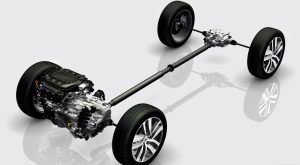
Another reference point is the VW Atlas, which also comes standard (and only) with a 2.0 liter turbocharged four that makes 269 horsepower (in the same ballpark as the output of the Honda’s V6) but only rates 20 city, 27 highway.
VW has dropped the previously available V6 you used to be able to get in the Atlas.
FWD Pilots can pull up to 3,500 lbs. but if you buy AWD, this goes up to 5,000 lbs. TrailSport versions (which come standard with AWD) comes with 8.3 inches of ground clearance vs. 7.3 for the others.
The Pilot looks like an SUV but drives like a car – which is the main draw of crossovers. They are not based on trucks and so don’t feel as heavy as the truck-based vehicles they’re not.
But they look like the truck-based SUVs, they’re not – and that’s part of the appeal. Another part of it is the SUV-esque feeling of elevation – of riding higher than a car (or a minivan). The Pilot’s like that – without being so high you need a step ladder (or running boards) to climb in it.
The current model rides on a longer (113.8 inch) wheelbase (vs. 111 inches previously) that both increases interior/cargo space vs. the ’22 Pilot and makes the ’24 feel more substantial than it was before.
Because it is.
The V6’s strongest suit is that it is a V6. And that it’s a Honda V6.
It’s difficult to convey the subtleties of both those attributes. Some turbo four-powered crossovers get to 60 about as quickly (that being in about 7 seconds flat) and some V6 powered rivals like the Kia Telluride do, too.
But Honda’s V6s are both glass smooth and eager revvers. The redline is just shy of 7,000 RPM, courtesy of the famous Honda VTEC (variable cam timing) system that ramps up the aggressiveness of the valve/cam timing at higher engine speeds while keeping it so smooth at idle you can’t tell it’s idling.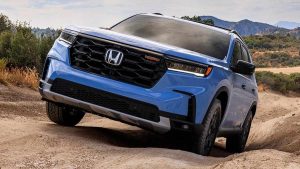
This engine is also a known 200,000 miler (and then some) which is worth a lot all by itself.
At The Curb
The Pilot looks less like a minivan than it did before – and more like the SUV it isn’t.
Its hood is broad and flat and extends several inches farther forward than before – until it abruptly ends in a vertical drop, rather than the previously tapered look. The grille is easily three times as large as before, too.
There’s also about three inches more Pilot now vs. before. At 199.9 inches long (vs. 196.5 inches before) the current Pilot is as close to being full-sized as it gets without moving up just a little to that class. A Chevy Tahoe (which is an SUV; it shares its underlying platform with the Chevy Silverado 1500 pick-up) is only about 10 inches longer. A Kia Telluride – which is a crossover like the Pilot – is 196.9 inches long and so right on the mid-sized money.
Honda upsized the Pilot chiefly to catch-up with the Telluride (and its Hyundai Palisade twin) which are its main rivals. The Telluride (and Palisade) used to have more room for cargo – 21 cubic feet behind their third row and 87 cubic feet with the second and third rows folded – than the Pilot. The previous (and mid-sized) Pilot had 16.5 cubic feet of space for cargo behind its third row and maxed out at 83.9 cubic feet. The new, just-shy-of-full-sized Pilot has 18.6 cubic feet of space behind its third row and 87 cubic feet of total capacity, exactly matching the Telluride-Palisade twins.
Eight passenger capacity is standard but you can swap out the standard second row bench for a set of captain’s chairs (just like a minivan). Unlike a minivan, the Pilot doesn’t have a pair of dual-sliding doors and that makes it not-as-easy to get in and out of the Pilot for people in the third row.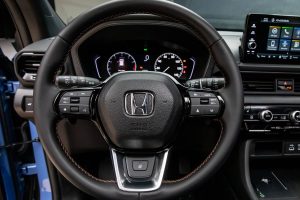
This is the main functional deficit you accept when you buy a crossover rather than a minivan.
All trims – including the base LX – come standard with seat heaters for the driver and front seat passenger as well as a smaller (7 inch) LCD secondary touchscreen and a primary instrument cluster with analog-style gauges rather than digital displays. The EX-L trim comes standard with a larger (9 inch) secondary touchscreen and if you want a digital display main instrument cluster, it’s standard in the top-of-the-line Elite.
Interestingly, the Pilot is now larger than the Passport – Honda’s other crossover that looks like an SUV. The latter stickers for $41,900 to start and is only 189.1 inches long.It also has a slightly less powerful (280 hp) version of the 3.5 liter V6.
And it only comes with seats for five.
Like pretty much every new vehicle, the Pilot comes standard with an array of what are called “driver assistance technologies.” These assume the driver requires assistance with such tasks as keeping the vehicle with its travel lane (Lane Keep Assist) and applying the brakes so as to avoid running into things (Automatic Emergency Braking). No doubt there are drivers who might need and benefit from such “assistance.” But it’s not an option – like a handicapped ramp. It’s included – and you pay for it in more than just the obvious way.
These “technologies” are really about controlling rather than “assisting” you. For example, if you attempt to turn off the road you’re on or pass a vehicle without signaling first, the Lane Keep Assist will try to countersteer you back into your travel lane. And Automatic Emergency Braking will sometimes stab the brakes – jerking you forward in your seat – when it thinks you’re too close to whatever its cameras see ahead. The object may not even be there (it could be just a tall berm by the side of the road) and it is often not close enough to be a substantive reason to stab the brakes.
This is not a criticism of the “technology” per se. It is a criticism of the odd fact that these “technologies” are being made standard equipment across makes and models and most buyers seem to dislike this stuff and would opt not to have their cars so equipped.
If they had the option.
The Bottom Line
The Pilot’s the minivan you always wanted – and the SUV you didn’t.
. . .
If you like what you’ve found here please consider supporting EPautos.
We depend on you to keep the wheels turning!
Our donate button is here.
If you prefer not to use PayPal, our mailing address is:
EPautos
721 Hummingbird Lane SE
Copper Hill, VA 24079
PS: Get an EPautos magnet or sticker or coaster in return for a $20 or more one-time donation or a $10 or more monthly recurring donation. (Please be sure to tell us you want a magnet or sticker or coaster – and also, provide an address, so we know where to mail the thing!)
If you like items like the Keeeeeeev T shirt pictured below, you can find that and more at the EPautos store!



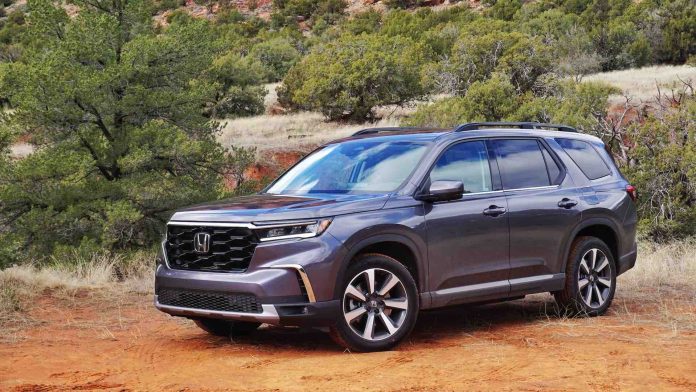

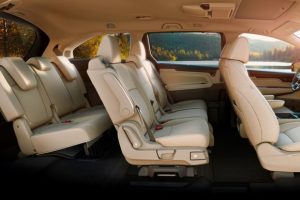

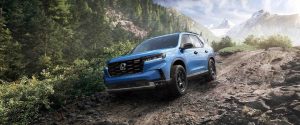








Our 200,000 mile 2011 Honda Pilot is the best, most reliable vehicle I have ever owned. You can tell if an older vehicle is reliable by how many are still on the road. I see this model everywhere.
It’s a true 4×4 on the truck chassis. It got me up and out of an icy ditch after sliding off the road miles from home with my young family. Any time there is snow/ice, this is the vehicle I use.
Bought it for a steal of a price for $25,000 in 2012 with about 10,000 miles on it from a family member. Before he passed away, I saw him every year at the family reunion and he always said he regretted selling it after I bragged about it being the best damned vehicle I’ve ever owned.
I’m rambling… It’s a shame they don’t make one like it any more.
My Pilot is a 2006 model. Has 250k miles. Runs like a new one except for a pesky P0420 check engine code which I clear from time to time. The car has good handling with respoinsive steering which is only inhibited by the standard T-rated tires. Rebound and recovery is excellent and the car sticks to the road while being responsive to the driver. The engine is eager and the transmission shifts flawlessly. It gets regular oil changes and a an annual 4 quart drain and refill on the transmission. Suspension parts get changed every 5 years or so to keep a good ride factor.
I am very satisfied with this car and would rather drive it 600k miles than replace it with a new one, however, it is good to see that Honda has maintained good build quality, its V6 engine setup and increased it’s size and utility. The safety nag features are too much to overcome.
Another big difference is accessibility. Same motor, but everything in the 2009 Minivan was relatively accessible. The 2021 Pilot is pretty much the opposite, with plastic coverings and air boxes even making battery access difficult. There is no shifter, btw, just nebulous electronic push buttons, any of which could have been my customer’s issue 2 days ago, who knows?
It is virtually impossible to follow up on an electronic failure, when it is not currently failing.
This is akin to servicing a cell phone on wheels. This garbage will likely require 50K in digital analysis equipment I do not, nor will ever, have the means to purchase. My usefulness, I’m afraid, is nearing its obsolescence.
My customer just dropped off his 2021 Pilot, 84K miles. Monday he called to tell me it would not start or crank in the 10 degrees cold. Today it drives in with no apparent defect with the battery, cables, or charging system whatsoever. I haven’t the heart to tell him it is an electronic device POS that is just going to be faulty and undependable in the extreme cold.
He bought this and traded in his 2009 Odyssey Van which had been so dependable that when I did the 1st timing belt and water pump job at 150K, everything that came out was like brand new, including the crystal-clear factory Blue Antifreeze.
I urged him to keep the Odyssey, but to no avail. I have no idea why seemingly rational people become fearful and paranoid regarding older, tried & true automobiles, and have become convinced that older means undependable. Especially when the opposite if often true, in my experience.
Amen, Graves!
My ’02 Nissan Frontier is completely reliable and (generally) very easy to service. PS: Can’t wait to show you my custom-made exhaust system. It’s not “sexual chocolate,” either!
Offtopic but funny: Putin drifts driving a Kamaz truck. See the video at the end of the article.
https://edwardslavsquat.substack.com/p/putin-mourns-death-of-extraordinary
Direct link to video:
https://www.youtube.com/watch?v=PQmntmjtXeE
Will the new DOHC V6 be as durable as the old SOHC V-tec? And what about that ten-speed transmission?
“A Chevy Tahoe (which is an SUV; it shares its underlying platform with the Chevy Silverado 1500 pick-up) is only about 10 inches longer”
A better comparison would have been the 2023 Chevy Traverse. It comes with a 310 HP 6/cylinder. The wheelbase is about 120 inches and the length is about 204 inches. It also has the largest cargo space with 98 cu/inches and can seat up to 8. The LT can be had with 4 wheel drive and a slew of options. With front wheel drive and the convenience package and towing with heavy duty cooling it can be had for about $41,000. Still a lot of money but WTH, what isn’t.
I like minivans as they are great for transporting 4X8 sheets and up to 8 people. I used to own the 1992 Plymouth Grand Voyager and the 2001 Chrysler Town and Country EX Minivan. They were very useful cars.
Have had a minivan and a pilot.
Each very useful and appropriate vehicles for hauling kids and mild four wheeling. Sometimes at the same time!!
Pilot was a much softer spring and nicer riding vehicle than van, but also more expensive.
Buy em both used and enjoy… while you still can!!!